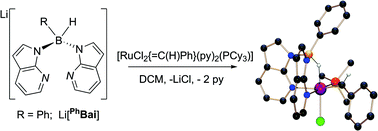Strong agostic-type interactions in ruthenium benzylidene complexes containing 7-azaindole based scorpionate ligands†
Abstract
The complexes [Ru(Tai)Cl{=C(H)Ph}(PCy3)] (4) and [Ru(PhBai)Cl{=C(H)Ph}(PCy3)] (5) [where Tai = HB(7-azaindolyl)3 and PhBai = Ph(H)B(7-azaindolyl)2] have been prepared and structurally characterised. The borohydride unit is located in the coordination site trans to the chloride


 Please wait while we load your content...
Please wait while we load your content...